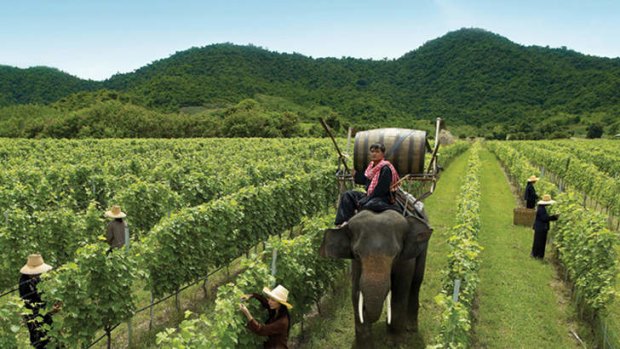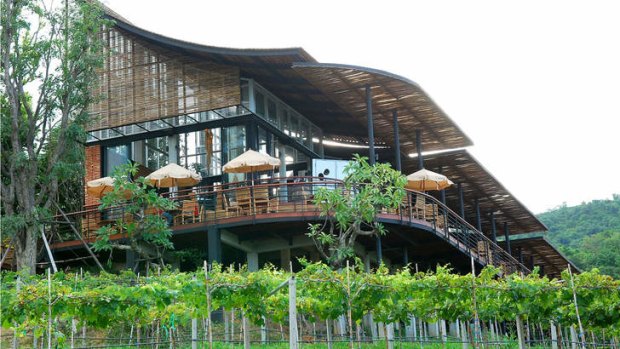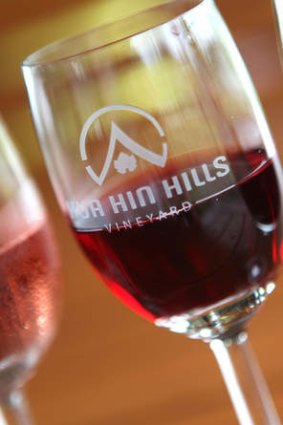
Tusk-an wines ... checking the grapes in the Hua Hin Hills Vineyard.
The local drop is fine and the pachyderms are unexpected, but David Whitley suggests looking out for the cobras.
The workers pruning the vines look overdressed for the sticky, sapping heat. They're covered from head to foot, sweating into their long-sleeve shirts and warding off the sun with big hats that drape down over the neck.
But it's the big white gumboots that look strangest. As we bounce along in the back of the Jeep, I ask the driver what they're for.

The Sala restaurant is the place for a taste test.
"Do you really want to know?" he asks. "OK, it's for the snakes. I've seen cobras here - brown and black."
I'd expected making wine in southern Thailand would be beset by numerous obstacles, but I hadn't factored in cobras.
The Hua Hin Hills Vineyard is a bold attempt to take winemaking into latitudes the grapes get tetchy about. A 45-minute drive inland from the coastal resort town of Hua Hin, it's where the Monsoon Valley wines found in Thai restaurants across the world are made. The lush hillside setting, with vines stretching across the horizon between lumpy green peaks, has been turned into a hub of activity.

The local product.
As we prepared to jump into the back of the Jeep, a group of cyclists returned. They had been huffing and puffing along the 225-hectare property's hillside tracks. With the heat and humidity, rather them than me.
The Jeep takes us past vast rows of Colombard and Malaga Blanc vines before pulling up outside the elephant stable. This would seem a ridiculous thing to have in a vineyard, but it's a piece of heritage. Before the vines were planted, the site was where wild elephants were domesticated.
Only three elephants live there now, and they take visitors on rides through the vineyard. We end up on Honey, a 45-year-old female with a freckly nose and unusual brown complexion.
From on high, the views of the valley as it plunges towards the coast are magnificent, and the neatly ordered blocks of vines offer a bizarre contrast with the tropical foliage around them. There are mango trees on the property, and the land just outside the vineyard is prime pineapple farming territory.
The main task of Jack, the mahout, is to stop Honey ploughing into the vines to grab a quick snack or two.
"She likes grapes," he says. Tough luck, lady - you'll have to settle for bananas and pineapples instead. We're allowed to hand-feed Honey after the ride, and she snaffles the fruit gratefully with her trunk.
Hungry humans can tuck into something a little more complex. The Sala restaurant has all the hallmarks of a destination restaurant in the Hunter or Barossa valleys. The prime seats are on a large open-air balcony, soaking up the viney view. But there are a few Thai touches - noticeably the pagoda-style roof and a menu that nods to the local as well as the international. Mains include crab-meat fried rice as well as grilled T-bones.
But for all the food and activity, Hua Hin Hills is really about the wine. A series of displays along the wall at the Sala show the techniques used to trick grapes into growing at this latitude. Loamy soil and ocean breezes help, but irrigation and vine protection techniques designed for the tropics - rather than copying traditional approaches - are the key.
There's a map of where wines are grown around the world. The likes of Ethiopia, Ecuador and Nigeria might come as a surprise.
The final activity of the afternoon is a taste test, in which a series of samples are lined up at the bar with tasting notes and suggestions of dishes with which they make a good match.
An emphasis is put on wines that work well in hot climates and with Thai food. A 2012 Colombard, billed as an alternative to sauvignon blanc, is a bit acidic for my liking. The white shiraz is surprisingly good, with a ballsy aftertaste that won't let spicy dishes run all over it, but the real winner is the chenin blanc, a varietal that's usually towards the bottom of my list. It has a sweetness that almost pushes it into dessert wine territory, but in the Thai climate it's invigoratingly refreshing.
I shouldn't be too surprised. If you plant a vineyard in Thailand and then let elephants wander around it, the usual rules don't apply.
FAST FACTS
Getting there: Thai Airways has a fare to Bangkok from Sydney and Melbourne for about $1075 low-season return, including tax. Fly to Bangkok (from Sydney 9hr 15min and from Melbourne 9hr 20min); see thaiairways.com. Taxi transfers to Hua Hin take two to three hours, depending on traffic, and can be pre-booked with Hua Hin Taxi for 3000 baht ($97.50). Phone +66 86 375 6972, see http://huahintaxi.com.
Staying there: The Sea-Cret (1/9 Soi Hua Hin 75/2 T.Nongkhae A.Hua Hin) is a small, romantic option with a fantastic pool and plenty of flamboyance. Deluxe Jacuzzi rooms cost from 3500 baht a night. Phone +66 86 329 6221, see http://theseacrethuahin.com.
Touring there A shuttle bus to the Hua Hin Hills Vineyard is available at 10.30am and 3pm daily from Hua Hin Hills Wine Cellar in the Market Village mall. Return journeys are at 2pm and 6pm.
Return tickets cost 300 baht. Phone +66 81 701 0222, see http://huahinhills.com.
Sign up for the Traveller Deals newsletter
Get exclusive travel deals delivered straight to your inbox. Sign up now.